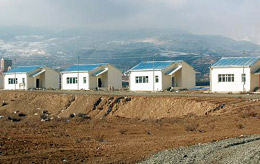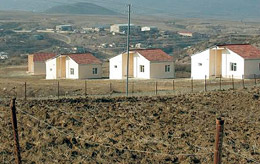Repopulation is An Essential Question for All Armenians
An Interview With Serzh Amirkhanyan, Director of the Office For Migration, Refugees and Resettlement Attached to the Government of the Nagorno-Karabakh Republic
- Does the Republic of Nagorno-Karabakh have an official program regarding resettlement? If so, how can we learn more about it? During the current year what type of work is being carried out and will be carried out and in what regions?
- The NKR government started to resettle refugees fromAzerbaijanas a result of the war immediately after the liberation of Shushi in 1992.
The NKR's resettlement policy has been formalized through any number of official acts and decisions.
In 2001 the NKR redefined and formalized its 10-year strategic resettlement plan, clarifying its objectives and geographic focus. This 10-year plan aimed to resettle a total of 36,000 refugees in the motherland during the years 2001 to 2010. According to the plan 10,000 apartments, 200 schools, health clinics, irrigation canals, roads were also to be constructed totaling about $120 million US dollars.
This plan was pan-national in scope and thus the call went out both toArmeniaand the diaspora for the necessary assistance in its implementation.
 |
 |
Despite its limitations, the NKR authorities have realized much of the plan and during the past few years have allocated some 1.75 billion drams towards resettlement projects, 750 million drams being invested in Kashatagh alone. Any one can visit the administrative offices and learn more about the 10-year strategic plan. The work schedule for 2007 resembles that of 2006 in nature and scope. We will attempt the construction of one to two new residences on damaged sites and the reinforcement of more than forty residences already on our lists (outside of Kashatagh), and the completion of 3 to 5 apartments annually.
- In the reports distributed to the media, the region of Kashatagh was not included. Does this mean that during 2006 no resettlement work was carried out there?
- Capital projects and apartment construction in Kashatagh is carried out by the NKR Ministry of Urban Development and the Regional Administration. The 2006 budget for new capital construction and capital repairs totaled some 723.5 million drams. Social expenditures for those resettling totaled some 36.1 million drams. These projects were implemented by NKR's Administration for Migration, Refugees and Resettlement.
- Were all the costs for housing construction and repair paid through the NKR's budget or through the largesse of certain benevolent organizations? If the latter is the case could you please name them?
- All the construction cited in our reports was covered by the government's budgetary resources.
- Could you please tell us how many houses were built in 2005 and in what areas?
- A total of 142 apartments were constructed in all regions, except Kashatagh. That's handled separately and our administration doesn't have figures for there.
- According to your 2006 report a total of 241 families from the Republic of Armenia and other countries were resettled in the NKR. During that same period 105 apartments were built and 38 repaired, totaling 143 apartments. Where do those other 98 families now live?
 |
 |
- Your figures don't take into account the 24 finished houses that we purchased. Permission to resettle and a variety of subsidies to cover transportation and moving costs are available throughout the NKR, but only to those officially registered by the government. 74 families moved back to their original residences. Thus in 2005, we were quite capable of solving the issues of housing for all.
- Are there programs to facilitate the resettlers' integration into the society? What type of credits are available now and what's planned for the future?
- The issue of grants and integration of those resettling was resolved according to the April 15, 2003 “Applicable Subsidies to Families Resettling in the NKR” report's decision 121.
- Many of those who have resettled complain about the quality of the housing? What's the reason for the poor quality of the construction? What's the cost to the government for the building of one new house?
- All of our construction is undertaken so that such complaints don't arise. The Ministry of Urban Planning and other self-governing bodies oversee quality control during the construction process. Upon completion, the regional architect and the village leader make a final inspection. All problems that are brought to our attention are fixed during the coming year. The cost of repairing partially built houses runs between 3-6 million drams and between 7-10 million for constructing new houses from the ground up. (See photos).
- What's the strategy regarding the Shahumyan region? What work is planned for this year and the next?
- Those people forcibly evicted from Shahumyan and other northern regions of Artsakh now live and work in New Shahumyan. The government assists them so that they remain in the country. Our program remains the same. In 2007 37 apartments were built in New Shahumyan.
- According to your report no activity took place in the Hadrut region. Why is this so and is it part of a wider political program?
- In 2006, we built 2 houses in the city ofHadrutand one in thevillageofAzokhfor the refugees. Here, various benevolent organizations are assisting in the resettlement program. The Tufenkian Foundation has completed 6 apartments in thevillageofArajamugh, the AGBU has completed 3 in Bareshen and 10 partially in Jrak, while the Yerkir civic organization will complete the construction of 7 apartments and schools in the Ichevanatun region by 2007-2008. There are no other civic or benevolent bodies undertaking construction of residences in Artsakh.
- How many villages in Kashatagh currently have no electricity and when are they expected to get it? Will any villages be electrified this year? Are there any studies regarding the amount of funds needed to electrify all the villages in Kashatagh? We have facts proving that the former regional governor absconded with most of the budget's funds allocated for the region.
- From 1994-2006 the district of Kashatagh operated independently. With respect to Kashatagh, the Department of Migration, Refugees and Resettlement drafted no projects nor implemented any such as it did in the other regions. As to the other issues you raise, it's your civic and journalistic duty to present all the facts you have at the disposal of the Chief Public Prosecutor in order to receive a full and accurate response.
- In the regions of Kashatagh and Shahumyan a variety of projects are being implemented by various organizations. How are you coordinating these activities and what sections of the NKR government are involved?
- According to the NKR law entitled “Philanthropic Endeavors” we cannot get involved in the work carried out by individual benefactors or charitable organizations. We can only encourage them to contact the appropriate government agencies beforehand in order that they might avail themselves of certain non-budgetary advantages we can offer such as tax abatements and operational transparency. We have a good working relationship with some of these organizations while others prefer to operate on their own and neither contact us beforehand or inform us of their intentions.
- In the beginning of this year some privileges were reinstated in Kashatagh. Why and by whom were these former privileges brought back into operation?
- As I've already explained, from 1994-2006 Kashatagh operated as a separate district and those people who resettled there were offered many advantages not found elsewhere such as Shahumyan and the outlying districts. These privileges included things like double wages for one wage earner and free limitless electricity. Privileges are a good thing and the more the better. But when your budgetary resources can no longer cover the cost of such subsidies you necessarily have to look cutting back in certain sectors. For example, in 2004 the Kashatagh Regional Administration owed some 350 million drams to “Hye Energy”. If the privileges were to be continued for a 10-year period only newcomers would be the beneficiaries. Then again such privileges would have to be made available not only to Kashatagh residents but to all. Today all have the right to these privileges on a just and equitable footing.
- Why did the NKR government place the resettlement issue on the back burner for such a long time and only lately given it priority?
- The NKR government has always viewed resettlement as a prime component in the overall strengthening and defense of our borders. Others may talk about this issue but the government is actually doing something.
During the years 1988-1992 more than 7,000 young Armenians gave their lives in the struggle for Artsakh's liberation and self-determination and as a result of the war unleashed byAzerbaijan. Today, there are about 700,000 Armenian refugees who now live inArmenia, the CIS countries and elsewhere. It is the patriotic responsibility of every Armenian to assist in their repatriation back to the motherland, to guarantee them housing and work, in order that they can contribute to the development and strengthening of the nation.
We expect nothing less than the collective will power and assistance of all Armenians to address this issue, with each person participating to the extent their resources will permit. The Department of Migration, Refugees and Resettlement is ready to share information and assist not only those who to resettle here but those who contribute to this cause.
 Videos
Videos Photos
Photos
Write a comment